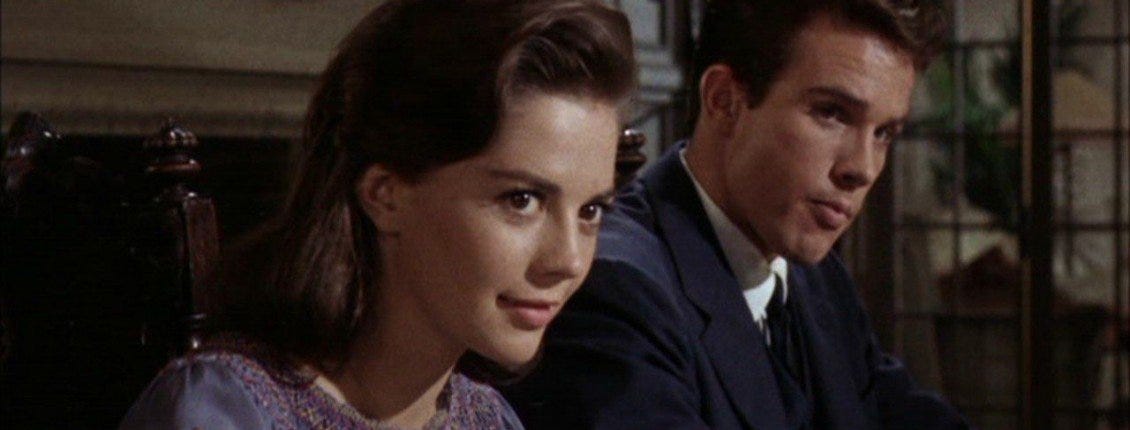Wood, burning
On "Splendor in the Grass" and movies that feel too much

I’ve often thought of “Splendor in the Grass” (1961, streaming on HBO Max; for rent on Amazon, Apple TV, YouTube and elsewhere) as the female version of “Rebel Without a Cause” (1955) and, as such, a rather more dangerous proposition. Both films star Natalie Wood, of course, but only “Splendor” puts her front and center as Wilma Dean “Deanie” Loomis, a teenage girl cracking from the sexual pressures and hypocrisies of her 1920s Kansas town. Wood is ardent and alive in “Rebel” but subsidiary to James Dean, whereas she owns every frame of “Splendor” with a sorrowful vibrancy that wrecks me every time I see the movie. It’s a performance that’s completely, helplessly present and it is heartbreaking – a young woman torn apart as much as Dean’s Jim Stark but for more genuine societal reasons than suburban malaise or seeing Dad in an apron.
Deanie wants to have sex with her boyfriend Bud Stamper (Warren Beatty, adorably dazed and confused in his first film role), and Wood makes you feel every exploding, inarticulate nerve ending of a young person’s erotic awakening. But she’s a nice girl, and nice girls don’t. They just don’t. Deanie’s prim-lipped mother (Audrey Christie) knows that, and even Bud knows that, which is why the dumb lug follows the advice of his rowdy oilman father (Pat Hingle) to find one of those other girls, the kind you don’t marry. So Deanie’s dumped for having to be what she doesn’t want to be – she isn’t even allowed to say what it is she wants – and the contradictions bring her internal operating system to a crashing halt.
Two separate scenes cradle the pain in a way that never fails to bring tears to my eyes. The first is Deanie rising up from the bathtub, hysterically insisting “I’m a good little girl, Mama!” to a mother who is suddenly looking into the abyss of a daughter’s madness. The second is Deanie at the prom, trying to pull a baffled and repelled Bud into the dark warmth of a car with the murmured plea, “I’m not, Bud… I’m not a nice girl…” Both moments, one loud and one eerily quiet, dance along the edge of breakdown in ways that can make the rest of the movie seem obvious and overdone.
“Splendor in the Grass” is a movie directed by a man (Elia Kazan, with whom Wood had wanted to work since seeing “A Streetcar Named Desire”) and written by a man (William Inge of “Picnic” and “Bus Stop”), but the fully felt incandescence of its emotions – the flame that at times seems to warp the frame – comes from the actress at its center. Wood was 22 when the film was shot, and her understanding of men and sexuality was already complex, probably traumatized. A child star who moved ambitiously into adult roles, she was 15 when, according to biographers, her mother Maria pushed Wood into a relationship with Frank Sinatra, then 38, and she was 16 when she pursued an affair with director Nicholas Ray, 43, during the making of “Rebel Without a Cause.” She told close relatives and friends that an A-list star brutally raped her when she was 16, but despite much speculation about who that star was – especially in the wake of a particular star’s recent death – attempts to establish his identity have never amounted to more than rumor. In any event, it seems safe to say Wood brought to the role of Deanie a knowledge and a confusion, an anger and an empathy, that was bruised beyond the actress’ years.
That said, I don’t think the movie’s impact is necessarily related to gender. I watched “Splendor in the Grass” the other night with my wife; it was my first viewing in a couple of decades and hers in who knows how long – a lifelong Wood fan, she knew she’d seen it at some point but didn’t remember any of the details. I sat there quietly weeping at the scenes mentioned above and others where Deanie’s feelings seem to overflow the film itself, and my wife was knocked over by the central performance while finding the rest clichéd and a little overbaked, with characters that verged on cartoons. Nor is she alone: film critic Dwight Macdonald famously trashed “Splendor” in Esquire, saying “I’ve never been in Kansas, but I suspect that parents there even way back in 1928 were not stupid to the point of villainy and that their children were not sexually frustrated to the point of lunacy.”

Okay, then. But Kazan always worked in a pitch of intensity that could topple into the purple; he liked the risk and he liked kicking the tight-asses in the shins, and if that got the thing called vulgar, all the better. (Anyway, while the director may not have known the time and place well, the Kansas-born Inge certainly did.) For me, the swooning angst of “Splendor,” down to that ham-handed waterfall metaphor (Deanie’s going over the edge, get it?), is a mirror of both the turmoil inside its heroine and a remembered adolescent turmoil inside myself. We use art and culture to express feelings we don’t know how to, and film is uniquely good at the job: We sit in the dark like penitents in the confessional. As a boy growing up in a family that never was comfortable with emotions, I found at around the age of 14 that old movies said things I couldn’t, in ways that were reassuring and, in retrospect, perhaps a little too safe.
It’s why I later was drawn to classic melodrama and “women’s weepies,” to the point of a 10-movie lecture series that served as a senior thesis in college. Genres you’re not supposed to like are always worth exploring, especially if you find them psychically useful: The U.K.-based critic Christina Newland just published a fascinating piece about how her love of crime films and noir stemmed from her own “glancing relationship to crime” – a good read even if you want more sordid details than you get. Similarly, while I’m married to a woman who expresses her emotions easily and doesn’t need a movie to operatically amp them up, the dramas that let (mostly) female audiences in the 1930s, ‘40s, and ‘50s test out what they could and couldn’t get away with have often simply allowed me to feel. Maybe that’s all that “Splendor in the Grass” does for me. But maybe that’s enough.
If you enjoyed this edition of Ty Burr’s Watch List, please feel free to share it with friends.
Or subscribe. Thank you!




